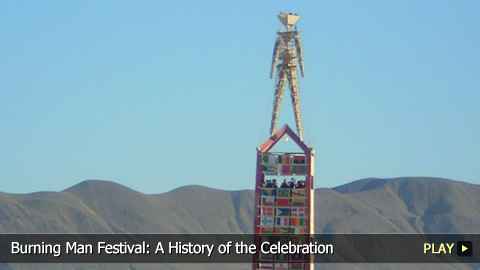Burning Man Festival: History of the Celebration

advertisement
VOICE OVER: Rebecca Brayton
The first Burning Man took place on June 21, 1986, and took place on a San Francisco beach. When groups of people swarmed to the huge burning effigy of a man that night, the founders knew they were onto something. Year after year, the effigies and the popularity grew. The festival is best-known to outsiders for that event, when a huge wooden structure shaped like a man is set aflame at the event of the festival each year. But Burning Man is as much about kinship, culture, self-reliance and art as it is about that. In this video, http://www.WatchMojo.com learns more about the origins, history and evolution of the Burning Man Festival.
History and Origins of the Burning Man Festival
This annual celebration takes place in the middle of the desert and always burns the man. Learn more about the Burning Man Festival.
Organic Origins
This festival started as a form of radical self-expression. The two founders built an 8-foot wooden effigy of a man and on June 21st, 1986, they set it on fire on a beach in San Francisco. When bystanders began to gather, the founders decided they should make it an annual event.
Change of Date and Venue
As the years progressed and the popularity of the event increased, the size of the effigy grew. By 1990, it was 40-feet high. Since the organizers did not have a permit, police intervened and prevented the bonfire that year. The event then transitioned from Baker Beach to the Black Rock Desert in northern Nevada, and took place on Labor Day weekend that same year.
Burning Man Pilgrims
This change of date and venue also saw the spirit of the event renewed. Active participation and a sense of community were important to Burning Man. Since the festival was now located in a desert in the middle of nowhere, guests made pilgrimages to get there.
Radical Self-Reliance
Eventually, as it expanded to a week-long event, attendees were also expected to practice radical self-reliance. Burners were asked to arrive at the site with everything they would need to survive a week in the desert, or be prepared to trade for it with other campers. The only things sold on site were coffee and ice.
The Growth of Burning Man
As of 1991, the event held the proper permits, and since that time it has continued to grow. In 1993, one thousand people participated. By 1995, the four thousand guests bought $35 tickets to the event, and that year Burning Man started a tradition of having themes for the week-long celebrations.
Black Rock City
In 2010, over fifty thousand people attended the Burning Man Festival, and ticket prices spanned between $210 and $360. 2011 marked the first time the event sold out. As the event grew, it necessitated the introduction of a temporary city on the grounds of the festival. Black Rock City is inhabited each year around the festival, and takes the shape of a series of concentric circles with roads connecting the various camps and villages.
Burning Man Principles
The event has also been governed by a set of principles that embraces inclusion, civic responsibility and active participation. Leaving no trace is also an essential part of Burning Man, and visitors are encouraged to dispose of their own garbage and waste at home. Another important part of the Burning Man experience is the art. Costumes and artwork are encouraged and often embody the theme of that year’s celebration.
Up in Flames
The temporary community of the Burning Man Festival combines music, art, ritual and a sense of kinship with a spectacular and large-scale celebration. But once the week is up, it all goes up in flames.


